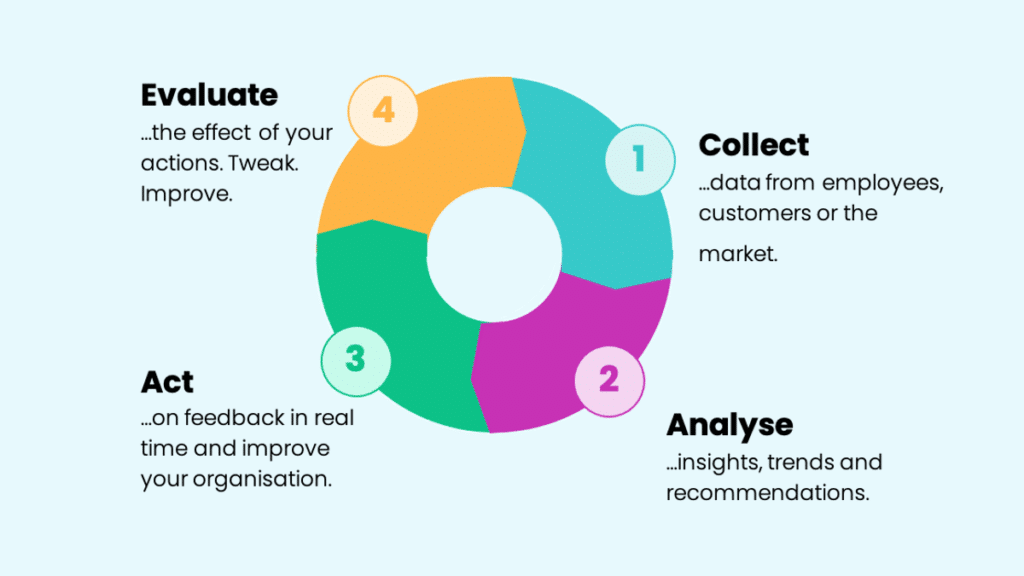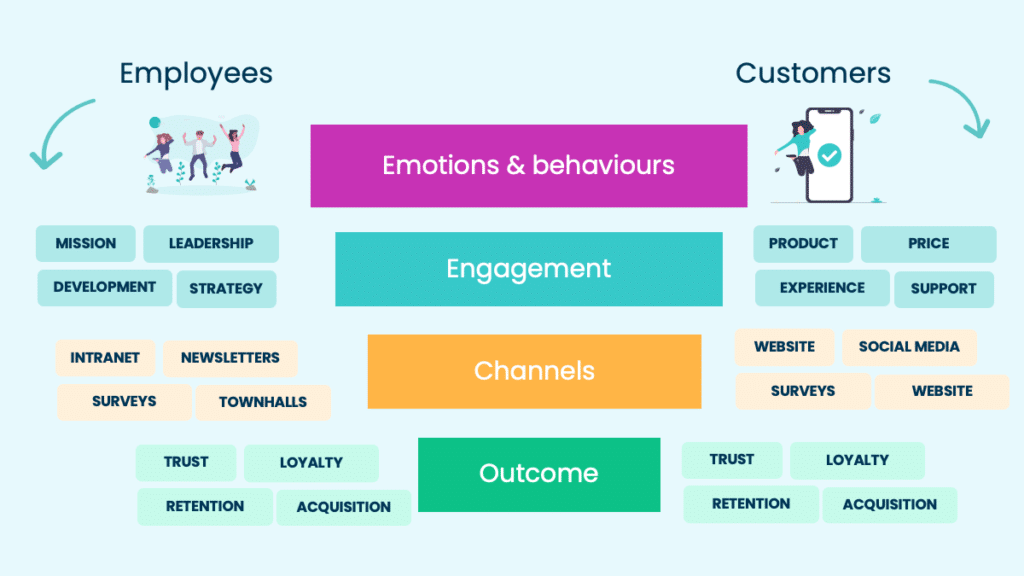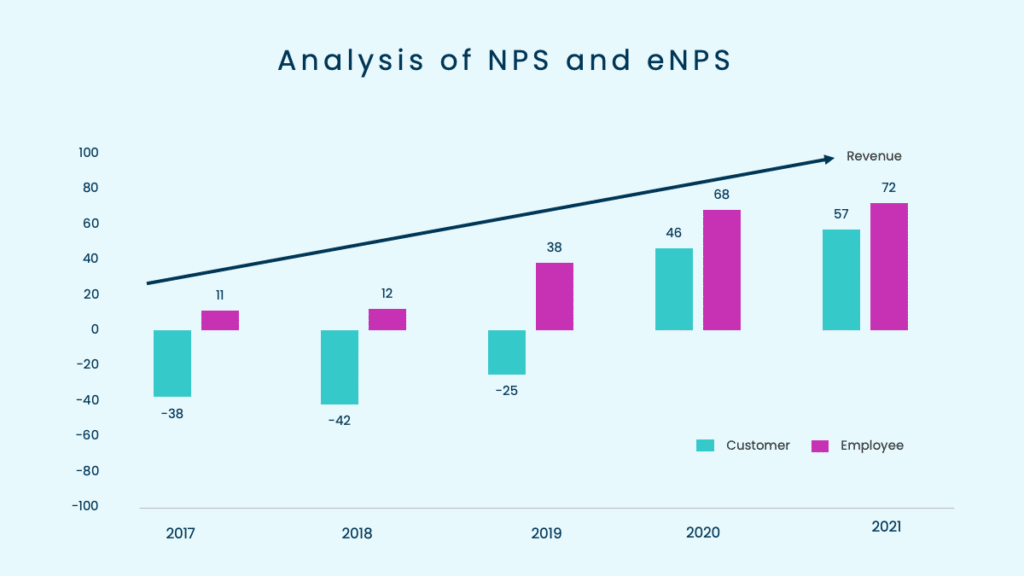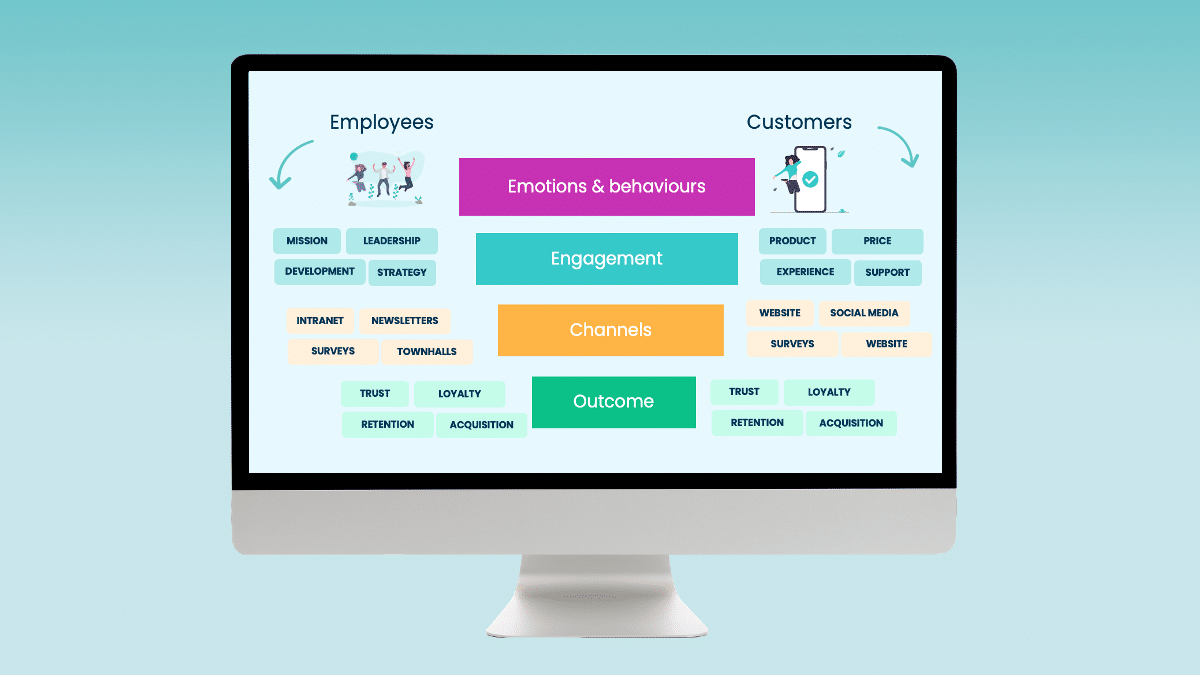Table of Contents
5 steps for using the power of feedback to improve your business
Let’s talk about the power of feedback. We can refer to it as ‘experience management’ or any number of similar terms, but ‘feedback’ seems simplest. It refers to what a person thinks of an experience, product, or service, and how they then relay that opinion to others. In terms of the employee experience, it encompasses a person’s feelings towards their work and employer. For businesses, this feedback has the power to influence positive organizational transformation. In this article, I present five steps for how you can harness the power of feedback to achieve this.
Watch our CEO’s talk on this topic during our Digital Connect 2021 event
1. Create a feedback obsessed company culture
The first step to releasing the full potential in people and organizations is to create a feedback obsessed company culture. Culture isn’t just about happy hours, vacation policy, or ping-pong tables. It’s about the ways in which employees approach their day-to-day work while fostering a sense of personal accountability for the larger organizational goals.
For companies— small or large— organizational culture has a tangible impact on the bottom line. A study conducted by Partners in Leadership showed that 96% of respondents felt that company culture is more important than strategy in impacting business results.
82% of employees appreciate positive and constructive feedback
Data shows that:
- 82% of employees appreciate positive and negative feedback.
- 40% are actively disengaged when they get little or no feedback.
- 43% of highly engaged employees receive feedback at least once a week as opposed to 18% of low engagement employees.
Source: Feedback: You Need To Lead It, Forbes
As the data suggests, leaders and organisations shouldn’t fear giving constructive feedback and should strive for open and transparent communication. If you’re able to foster a feedback-oriented culture in your company, your employees are more likely to thrive. As a result, you can expect to see higher levels of engagement which will positively impact profitability across the company.
2. Create a clear structure and processes for collecting feedback
The first step, creating a feedback culture, relates to the why aspect of utilising feedback. Addressing the how comes down to establishing the structures and processes around feedback.

At its core, defining a clear feedback process is simple. The first step is to have a robust system in place for collecting feedback from employees and customers. Step 2 will involve analysing the feedback you collect in order to identify insights, trends and recommendations. The third step, acting on your feedback, is the most important of all. Only by acting on the feedback you receive can you have a real impact on your people and organization.
Furthermore, when you ask people for feedback, there’s an inherent expectation that you will listen, absorb, and put the feedback to work. The final step, therefore, is to evaluate the effect of your actions. This helps you to make sure that you are implementing positive changes that continue to move the needle for your business.
3. Create one feedback journey
The customer journey and the employee journey have been buzzwords for a while now. And with good reason: it’s important to define, gather feedback on, and improve them. Once you do this, they allow your organization to deliver consistently positive experiences. The challenge, however, is considering how these journeys are intertwined and what your business can learn from this.
You can describe and design the customer and employee journeys in many different ways depending on your business. Until recently, it has been common to see the two journeys treated as entirely separate entities, with few to no touch points between the department dealing with them. Alongside this, there can also be the issue of both journeys being absent from management discussions, which means that there is no top-down focus on aligning the them. This is problematic because without alignment you’re missing out on the opportunity to capitalise on how each journey can positively impact the other.
The correlation between the employee and customer journey is an important one to understand. When employees don’t feel fully engaged or satisfied, for example, this can negatively impact the customer experience. On the flip side, if your customers are consistently unhappy that can very quickly negatively impact employees.

With this in mind, it makes sense to begin considering the two journeys in parallel. Looking at the example in the diagram above, you can see that there is no separate customer experience mapping or employee experience mapping. Since these two groups are so interconnected, it’s about applying a similar structure to creating good experiences for employees and customers alike.
There are a few questions you can ask yourself to begin mapping your own employee and customer journeys in the same way: How are you picking up on the emotions and behaviours of your customers and employees? How will your business work to create relevant engagement with them? Which channels can be used to effectively communicate with customers and employees?
Once you consider these questions and begin to map out your answers, you can measure the outcomes using the same types of KPIs for both.
4. Visualise data
Your data is the foundation for being able to analyse and harness the power of feedback. To release the full potential in people and your organization, you need to be able to visualise how successfully your company is moving in the right direction. Without data, you’re more likely to depend on gut feelings and individual biases, which leaves room for getting it wrong.
Let’s consider an example of this from one of our customers. Back in 2017, the CEO of the company started to measure NPS and eNPS in parallel. He was confident that the feedback they had received from 2017 up to today had revolutionalized their business. You can see this represented by the ‘Revenue’ line in the diagram below.

Every quarter when they conducted their surveys, they took the initiative to act quickly. This enabled them to see improvements quarter after quarter. Ultimately, the company identified a clear correlation between NPS, eNPS, and the growth revenue numbers. This illustrates the importance of correlating your data points and considering them in the context of your business.
5. Test your decisions with employees and customers
The final step in harnessing the power of feedback is to test the effectiveness of your actions with your employees and customers.
When tailoring any of your engagement programmes and acting on feedback, you should look back to the people who matter to make sure it’s working. When you’re ready to launch a new experience or product, consider testing it small groups and asking for feedback as your move forwards. This will re-affirm the value of your product and make you feel confident in the ongoing decisions you’re making.
The last thing you want is to implement changes that your audience don’t want. So it’s wise to ensure that testing and evaluating is a key, ongoing component in your feedback process.
Connect the dots between EX and CX
Happy employees lead to happy customers, and this is the key to sustainable business success. If you are invested in managing and improving the experiences that matter to your business, check out the video recordings of our Digital Connect 2021 event, where a panel of experts come together to join the dots between EX and CX. Or if you feel like getting started with NPS software or other feedback surveys, check out our Netigate resources.
-
Helena Bjorkman
-
Helena Bjorkman
- 5 min read
- .







 Copyright © 2025 Netigate AB, Drottninggatan 25, 111 51, Stockholm, Sverige
Copyright © 2025 Netigate AB, Drottninggatan 25, 111 51, Stockholm, Sverige